Interview
Rene H. Arceo: Indelible
In the tradition of the “The Next Chapter” interview feature highlighting insights and institutional memory from Academic elders, “Indelible” will be a semi-regular interview where a printmaker will have a conversation with an influence or mentor. The unique intimacy of the international printmaking community means most of us will, or have, met and worked with many of our print heroes. “Indelible” allows our membership to celebrate those relationships. In this first edition, San Antonio-based printmaker, Celeste De Luna of Metztli Press, interviews Mexican born, Chicago-based printmaker, René Hugo Arceo.
René H. Arceo Biography:
I was born and raised in Mexico and moved to Chicago in 1979. Graduated from the School of the Art Institute with a BFA with emphasis in printmaking and a Teacher Certificate. For 13 years I worked for the National Museum of Mexican Art, as the first full time employee I developed exhibitions programs, curated exhibitions, did graphic and exhibition design, educational programs, arts director, and special projects director. From 2000-2007, I was a visual arts coordinator Chicago Board of Education managing their 1500 artworks collection and worked with the district’s educators. From 2007-2019, I taught K-8th grade general art at Monroe School.
The co-founder of Galeria Ink Works (1984-87) and the Mexican Printmaking Workshop (1990-96), and in 2005 I founded Arceo Press to build bridges through print exchanges with artists and to foster international collaborations among printmakers living in different countries. Arceo Press has published fifteen limited edition print portfolios with artists from the United States, Mexico, Spain, Canada, France, Nicaragua, Costa Rica, and Puerto Rico.
Artist Statement
In my works I explore several aspects concerning humanity including a search for an essence of life, of living, of being, of the inner self in relationship to one another and the environment; both natural and manmade. This evocative humanity is represented through figurative elements like portraits, masks, women and men, vegetation, and the land in eclectic styles. I am constantly searching for a pictorial method to break away from illusion to create visual impact. Using a simple subject matter to create an intricate visual movement with complex spatial interactions between the figure and the space. My works derived from conscious and most often unconscious experiences and are, to a great extent, the result of spontaneous marks, patterns, or color that evolve into a final work.
En mis obras exploro una serie de aspectos relacionados con la humanidad, incluida la búsqueda de una esencia de la vida, del vivir, del ser, del yo interior en relación con los demás y con el medio ambiente; tanto natural como artificiales. Esta humanidad evocadora se representa a través de elementos figurativos como retratos, máscaras, mujeres y hombres, la vegetación y la tierra en estilos eclécticos. Busco constantemente un método pictórico para romper con la ilusión como forma de crear impacto visual. Mediante el uso de un tema simple para crear un intrincado movimiento visual con complejas interacciones espaciales entre la figura y el espacio. Mis obras se derivan de experiencias conscientes y con frecuencia inconscientes y son, en gran medida, el resultado de marcas, patrones o colores espontáneos que evolucionan hacia una obra final.
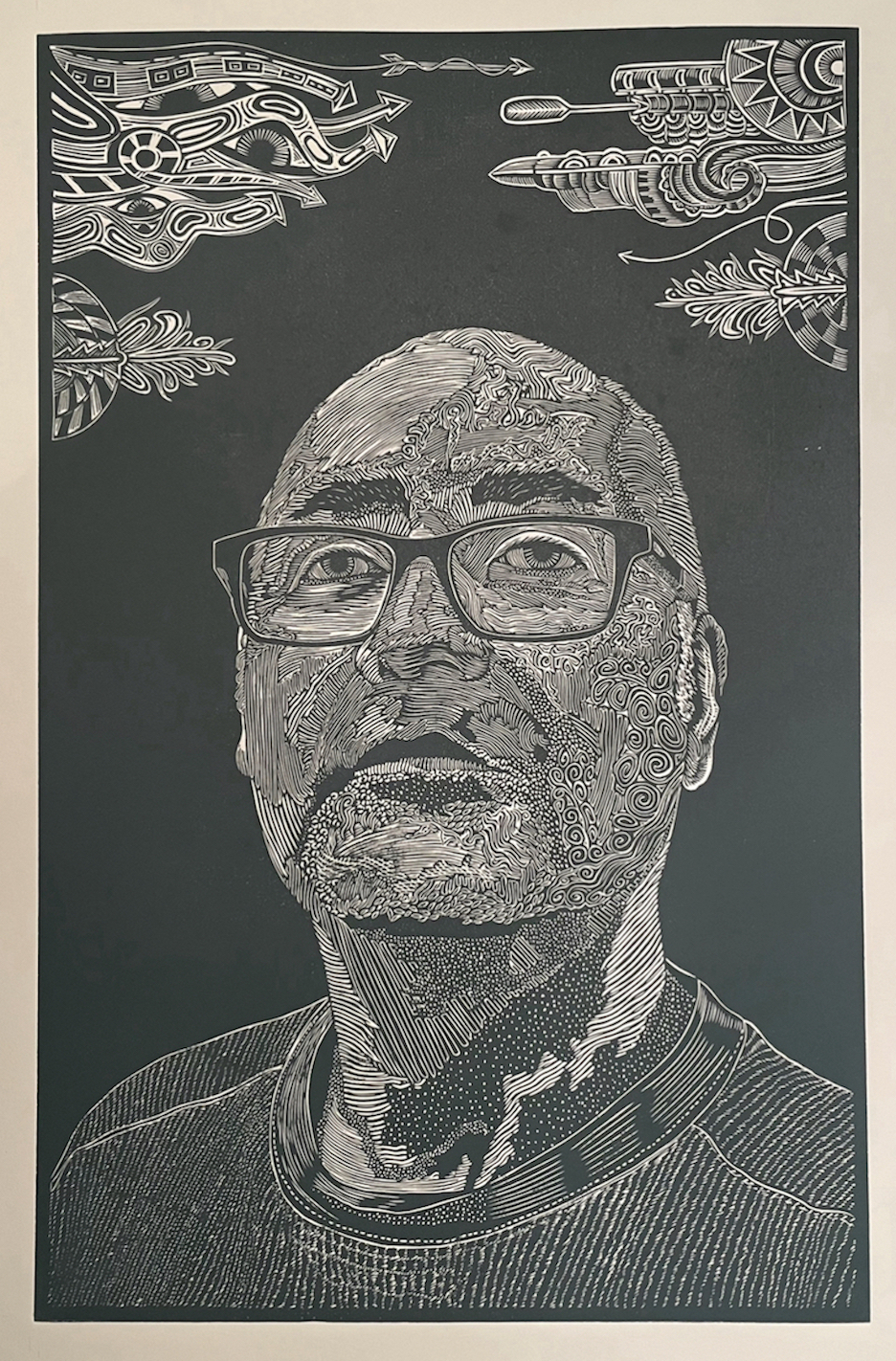
Self-Portrait
Linocut, 2021
Title
René H. Arceo: Indelible
Author
Celeste De Luna
Category
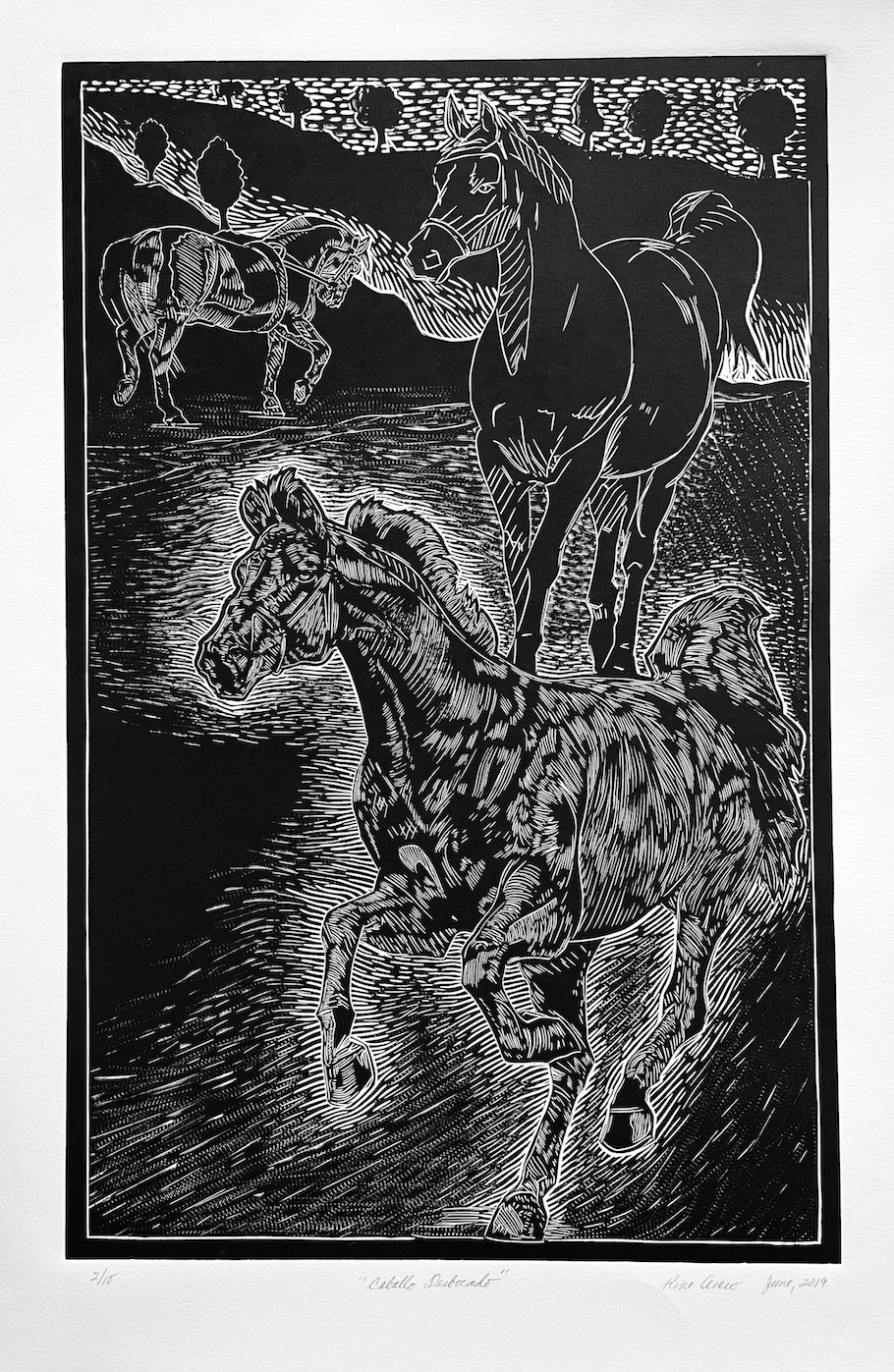
Caballo desbocado
Linocut, 30×22, 2019
The Interview
Celeste De Luna: Why use printmaking as a medium? What do you see as the future for printmaking?
René H. Arceo: I use printmaking as my medium for several reasons. First, there is a historic tradition in Mexico, where I was born and raised until age 19, that has influenced me deeply. I remember liking my public school textbooks because they included illustrations in the form of prints by many of the well-known printmakers. When I started studying at the School of the Art Institute, I began to learn more about artists from all over the world including Mexican artists. That was the moment I realized how important those early images of prints were to me. It was an eye-opener to learn the actual names of the artists who had made those prints including Leopoldo Mendez, Alberto Beltran, Sarah Jimenez, Mariana Yampolski, Adolfo Mexiac, Alfredo Zalce, etc. I was happy that I was able to meet these last three artists. Learning about the history and production of the TGP (Popular Graphics Workshop) collective and their commitment to social causes, justice, their 1930s call against fascism in Spain, Italy and Germany. In some ways it was like coming home since I was politically active during my high school years back in Mexico. Now in Chicago the learning of the TGP gave me some pride and admiration for the achievements of the collective and individual mastery. In an effort to replicate the TGPs idea and purpose, I co-founded the Mexican Printmaking Workshop in 1990. While living in Guadalajara city, I became involved in solidarity committees in support of the struggles of the people of Zimbabwe and Vietnam.

Housing is a Right
Linocut, 22″ x 30″, 2019
CDL: Can you tell me who were some of the original members of Chicago’s Mexican Printmaking Workshop?
RHA:
Nicolas de Jesus, Tomas Bringas, Gerardo de la Barrera, activist Carlos Cortez, Carlos Villanueva, Hector Duarte, and Benjamin P. Varela.
After exploring many different areas in art including ceramics (throwing and hand building), figure drawing, egg tempera painting, oil painting, acrylic, and hand dyed fiber, I landed in the printmaking department. I fell in love with the print media including intaglio, lithography, screen printing and naturally relief prints. During my school years I received a college-work-study position to collaborate with local non-profit organizations designing flyers and posters demanding moratorium on deportations, etc. This included the Midwest Coalition in Defense of Immigrants and MIRA (Mi Raza Arts Consortium).
Prints have a special beauty and magic for me. On one hand, the beauty and the enjoyment of the process while carving each individual line and texture, and on the other hand, the magic and often surprising results after pulling the first impression. I enjoy working with and printing on paper. An additional and final element of great interest to me is the fact that multiplicity can contribute to reaching larger audiences while subsequently making the artwork affordable or more accessible.
I think there is a great future for printmaking. I have experienced an effervescence in the number of printmakers, print exhibitions, print collaboratives popping up all over my city, in the country, and Latin America. I have been publishing limited edition print portfolios since 2005 and every year I meet a significant number of new printmakers of all generations. The significant active graphic dissent in the current climate and political arena in the United States is evidence that the graphic arts are well and healthy.
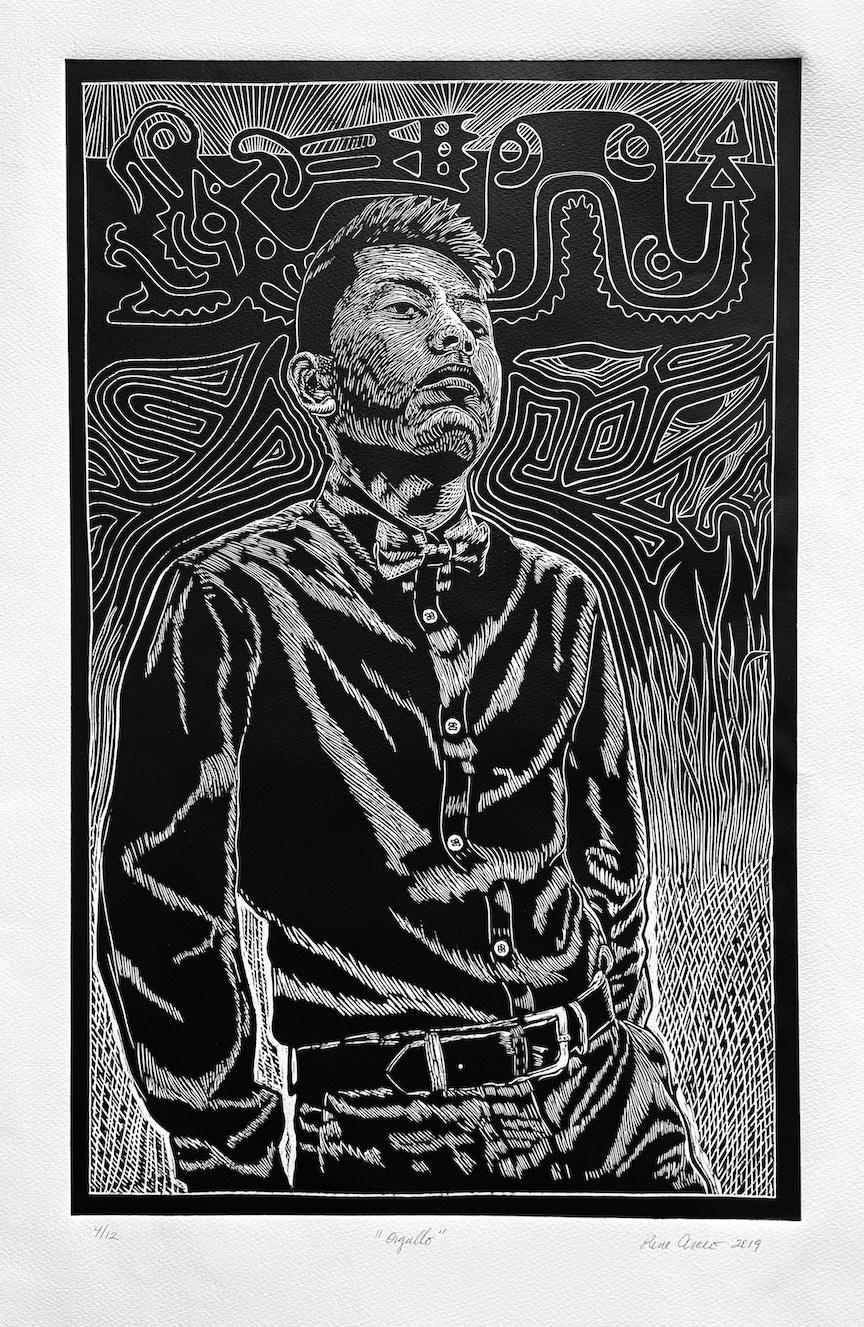
Orgullo
Linocut, 30″ x 22″, 2019
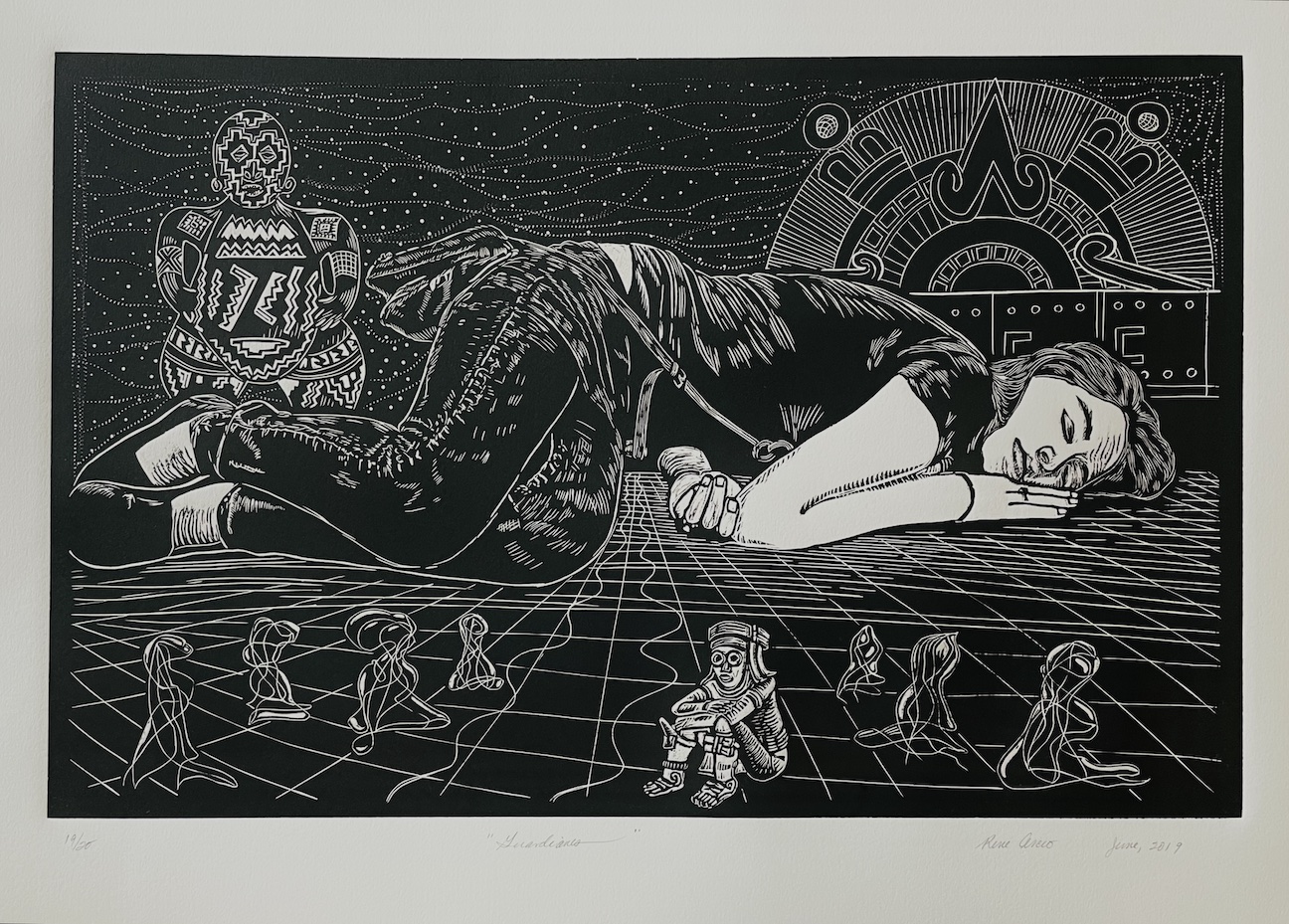
Guardianes
Linocut, 22″ x 30″, 2019
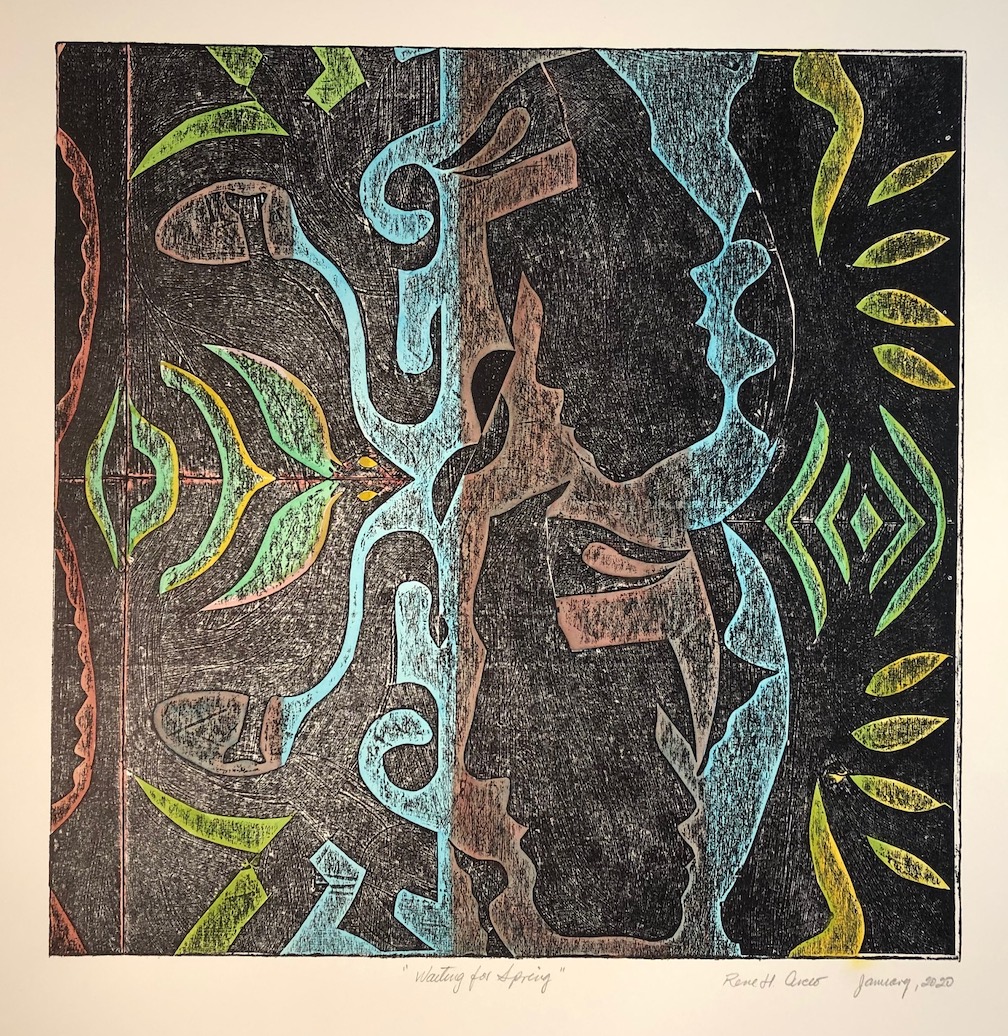
Waiting for Spring
Collagraph & watercolor, 25″ x 20″, 2020
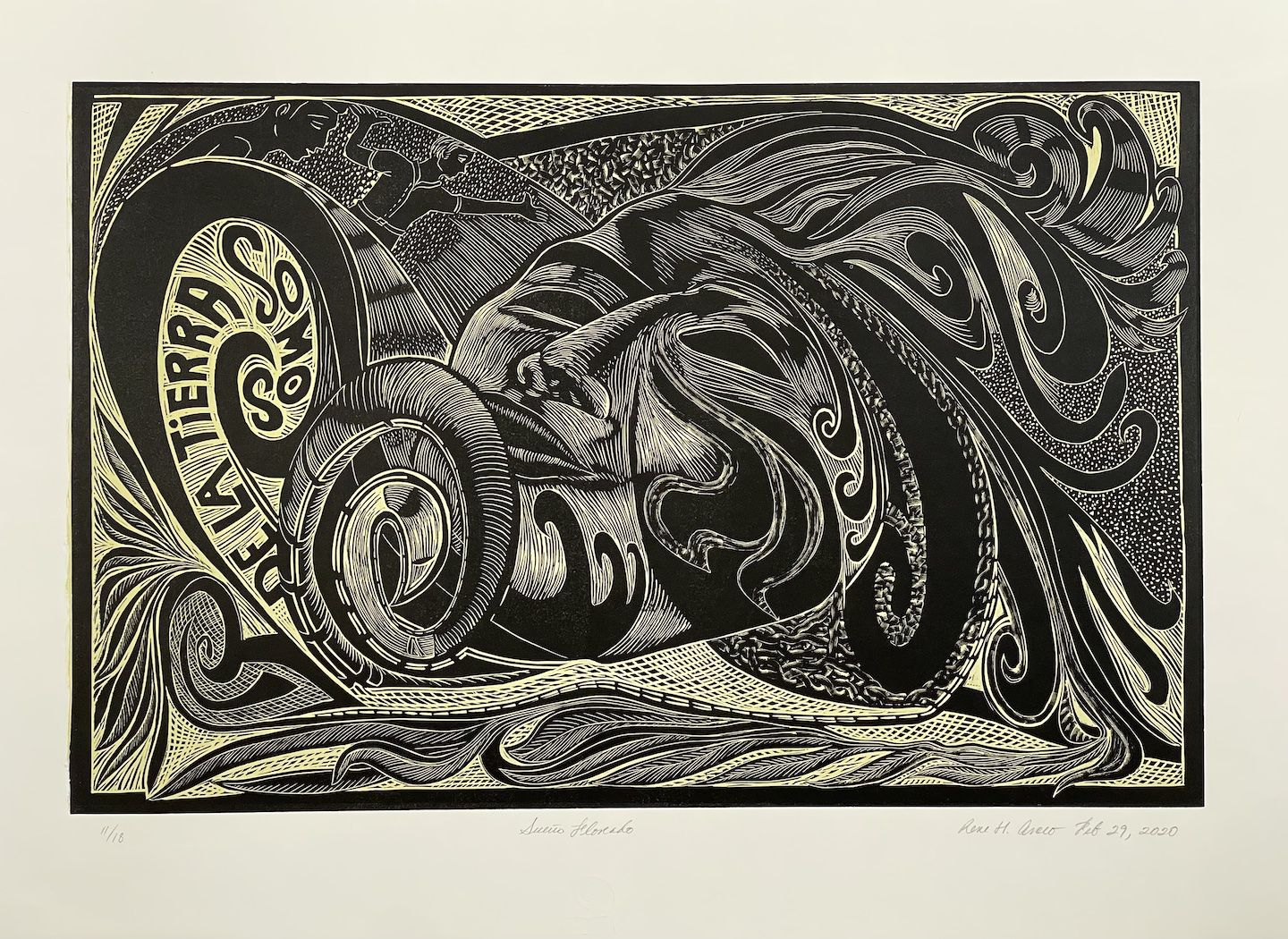
Sueno Floreado
Linocut, 22″ x 30″, 2020
CDL: Can you tell us about the city images juxtaposed against more rural Mexican iconography in your artwork? How does it relate to your own life?
RHA: I don’t create rural images as much as faces of common people, farmers, indigenous, Mexican heroes, family, and friends. I have always admired the qualities and energy of Mexican prints, including those of the Taller Grafica Popular members, with the capacity to transcend a mere portrait and to capture the spirit of the person. That is one of my aims.
Over the last three years, I have been working on collaborations with one hundred printmakers from Michoacan and twenty-five from the Chicago area. Those three projects have involved cultural aspects that reflect subjects of my home state like monarch butterflies that migrate there and spend the winter in the monarch’s sanctuary. Day of the dead tradition and guitars from Paracho, Michoacan have been other subjects we have addressed. In 2003 we did the first binational collaboration with a portfolio called “Bajo un mismo Cielo” (Under the same sky) dealing with the experience of coming from Michoacan but living in Chicago for four decades. Printmakers from both countries created prints linking in some way the two places, the two experiences. So, in my case, I did combinations of elements echoing experiences and elements of both. In one case, I did a monarch butterfly above Chicago’s cityscape. The wings of the butterfly were made from people’s faces to represent the spirit of those who, like me, had migrated north. The second print included traditional white fish, found only in Lake Patzcuaro, Michoacan, swimming in the Chicago River. The third print the combination of two faces partially merging and creating a third face: two experiences, one identity.
I can say that my heart is in Mexico, even after I have lived in Chicago for four decades. The thing is that I left Mexico, but I have gone so many times that I got to visit most of the 31 states and Mexico City. I traveled twice or three times per year during the thirteen years I worked for the National Museum of Mexican Art, I have brothers and sisters living there, and then I exhibited in Michoacan’s capitol, Morelia several times, individually and collectively over the years. It is funny to me that when I’m there and they realize I reside in Chicago they call me “pocho” which I’m not as this term defines someone who loses their first language. They refer to me as Chicano which I don’t feel I am. I refer to myself as a Mexican living in Chicago. Chicago has one of the largest populations of first generation Mexicans who did not experience the Chicano movement. There wasn’t much of that movement experienced in the Midwest, while I remember supporting Cesar Chavez and Dolores Huerta’s boycott against grape growers in the early 80s. Chicago stores were picketed until they stopped selling grapes.
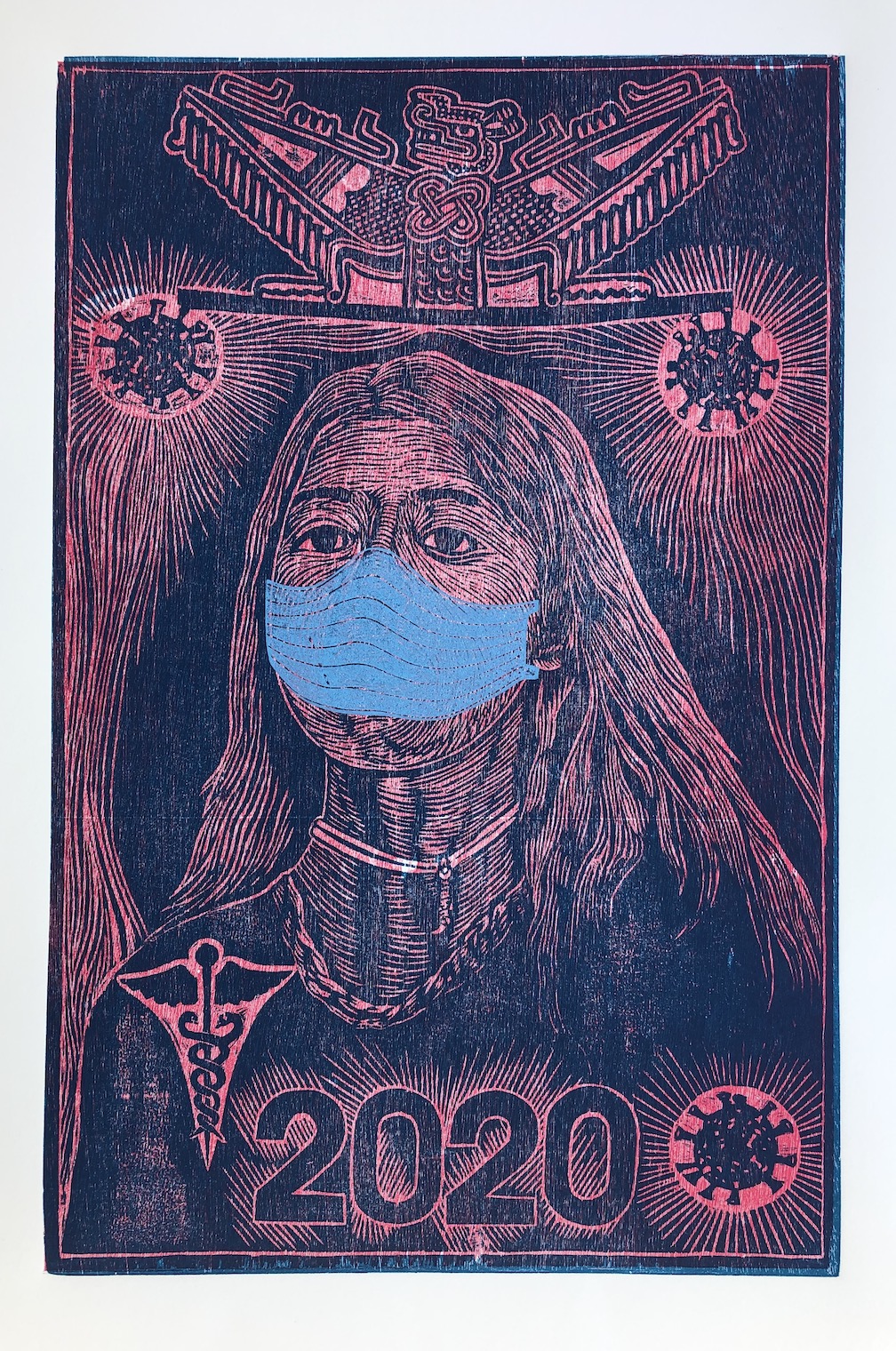
Murcielago-Virus (Bat-virus)
Woodcut & linocut, 30″ x 22″, 2020
CDL: What role does the artist have in society?
RHA: Human, social, and sometimes political commentaries are the common themes addressed in my prints. I feel that as a member of a given society the artist should, in a non-dogmatic fashion, artistically react or respond to social, economic or even political accounts and events taking place in our world today. This wouldn’t be in place of, but rather in addition to, expressing other universal concerns and feelings and artistic explorations. My feeling is that artists must reflect, in lesser or larger commitments, their own time and place. Not unlike Picasso did with his response to the bombing of the Spanish town of Guernica, or the powerful etchings created by Francisco Goya in response to the disasters of the war he experienced during his lifetime.
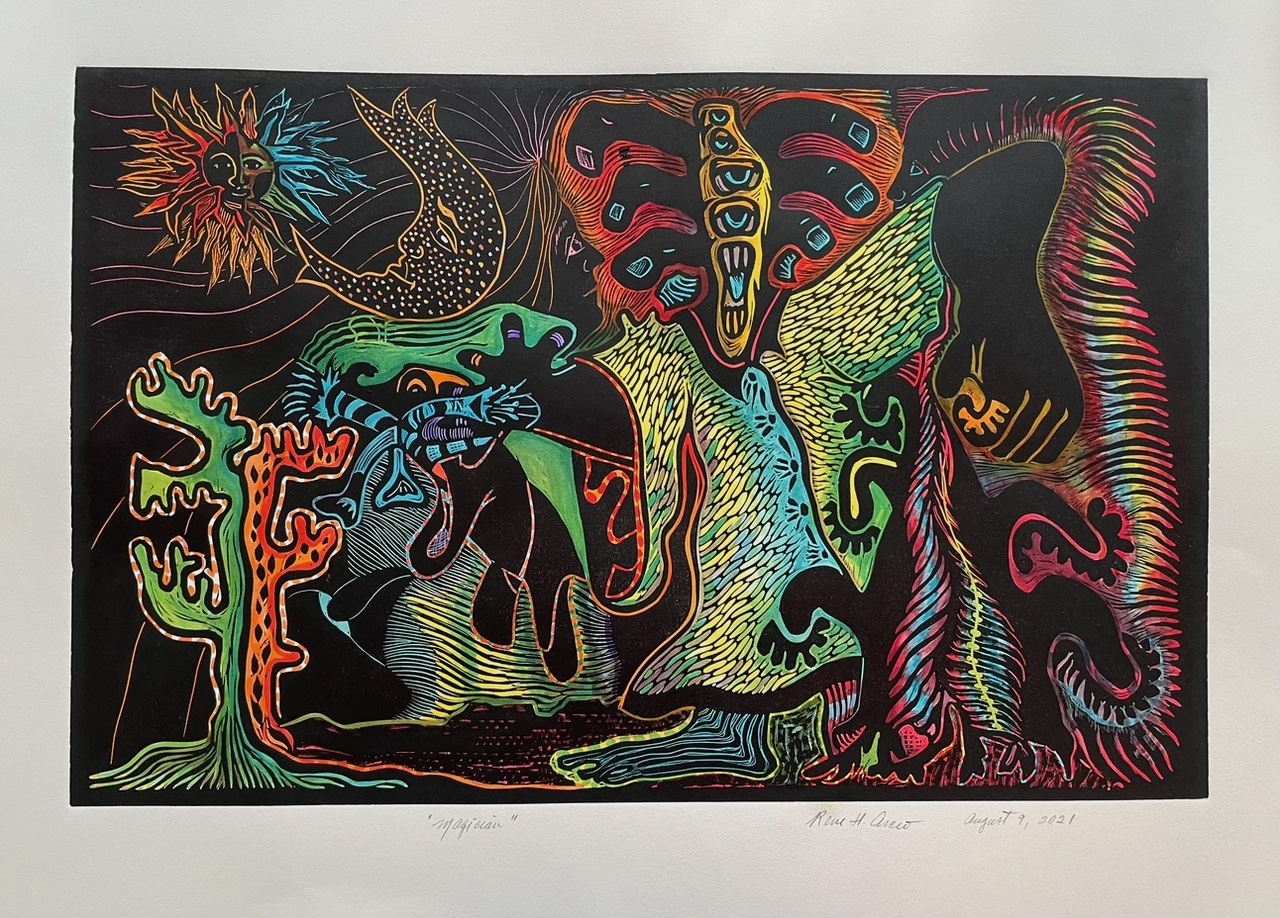
Magician
Lino & watercolor, 22″ x 30″, 2021

Lincoln
Linocut, 35″ x 28″, 2019
CDL: What themes do you continue to pursue in your work? Is the nagual one of them?
RHA: I reflect on aspects of identity and cultural affirmation. Since I was a teacher for two decades, I realized that students do not see themselves reflected in the images PowerPoint presentations traditionally included. I had to add images of Mexican, Chicago and other Latin American artists to better reflect my student population. Thereafter, I have done several large linocuts depicting young Mexican people in poses reflecting pride, so that youngsters can see themselves in them. I create new works based on projects I’m invited to participate in including displacement and gentrification of the Mexican barrio of Pilsen, Contra/Against portfolio organized by Instituto Grafico de Chicago as a response to the far right politics flexing their muscles. Portfolios about water pollution, oil fracking/pollution by the big companies, etc. I don’t do a series of works but the nahual re-appears from time to time in the larger body of work. I have done several nahual based pieces since 2007 when I organized two print portfolios called Bestiary and nahuals.
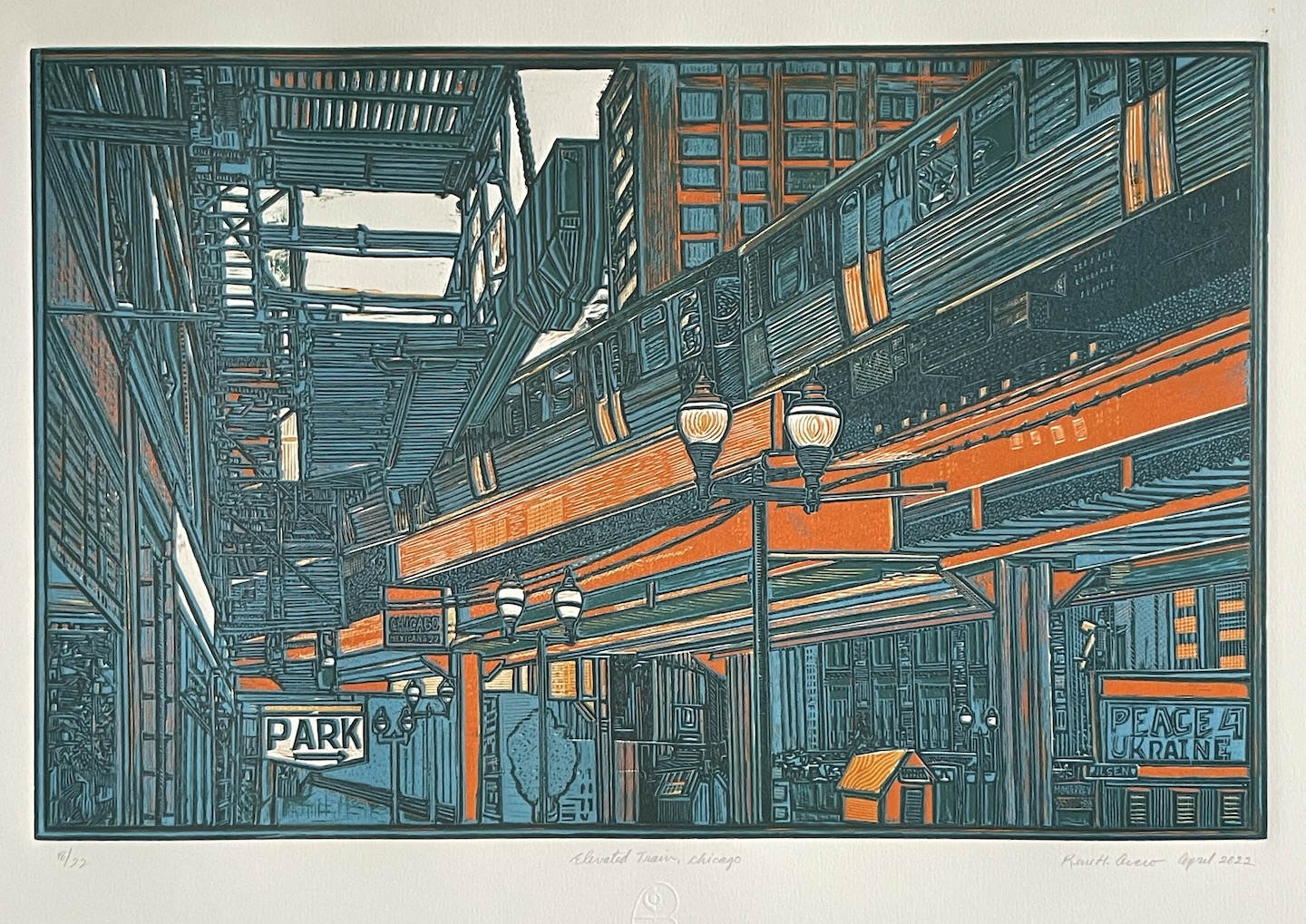
Elevated Train
Reduction linocut, 22″ x 30″, 2022
CDL: I know you were born in Michoacan but also have lived for many years in Chicago, working, teaching, collaborating. Do you consider yourself a Chicano artist? What is Chicano Art?
RHA: Yes, I have lived most of my life in Chicago, but having been raised for almost two decades in Mexico, leaves a permanent and strong sense of Mexicanidad in me. I understand the history and political vision of the Chicano movement and support it. The movement was and continues to be, a struggle to be represented and respected as people with specific history, identity, and rights. It is profoundly rooted in and connected to Mexican ancestors. Therefore, the notion that the border land belonged to our ancestors as such, is our land and one land that belongs to all the raza. Before there were political borders there was one land, the ancestors’ land.
If I had grown up here or even been born here my outlook towards the world would have been different and possibly call myself a Chicano. I don’t know. My oldest son, who is also an artist, decided to identify himself as Mexican- American. He knows about the history of the USA from slavery to the civil rights and the Chicano movement. It is a debate we had in the late 1980s with the founders of the “National Museum of Mexican Art” rather than the “Chicano Museum”, “Mexican-American Museum” or “Mexican Museum”. vs Mexican American or Mexican. The conclusion was that all those terms draw you back to the origins, to the root or source of it all: Mexico. So the term Mexican stayed and it is inclusive of all other definitions people have of themselves, but always with the connection to the origins.
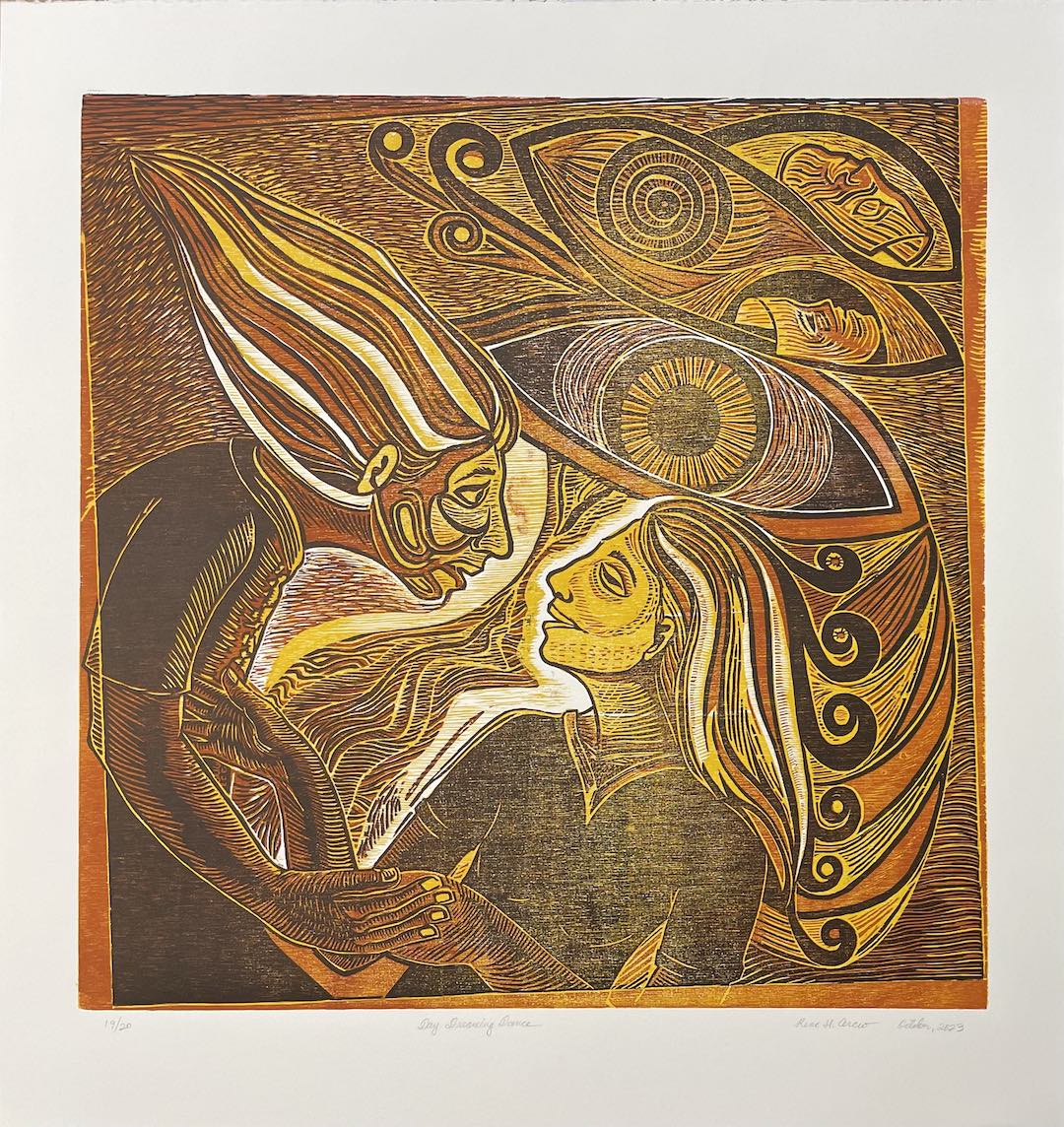
Day Dreaming Dance
Reduction woodcut, 28″ x 26″, 2023

Mestizaje
Linocut & chine colle, 22″ x 30″, 2018
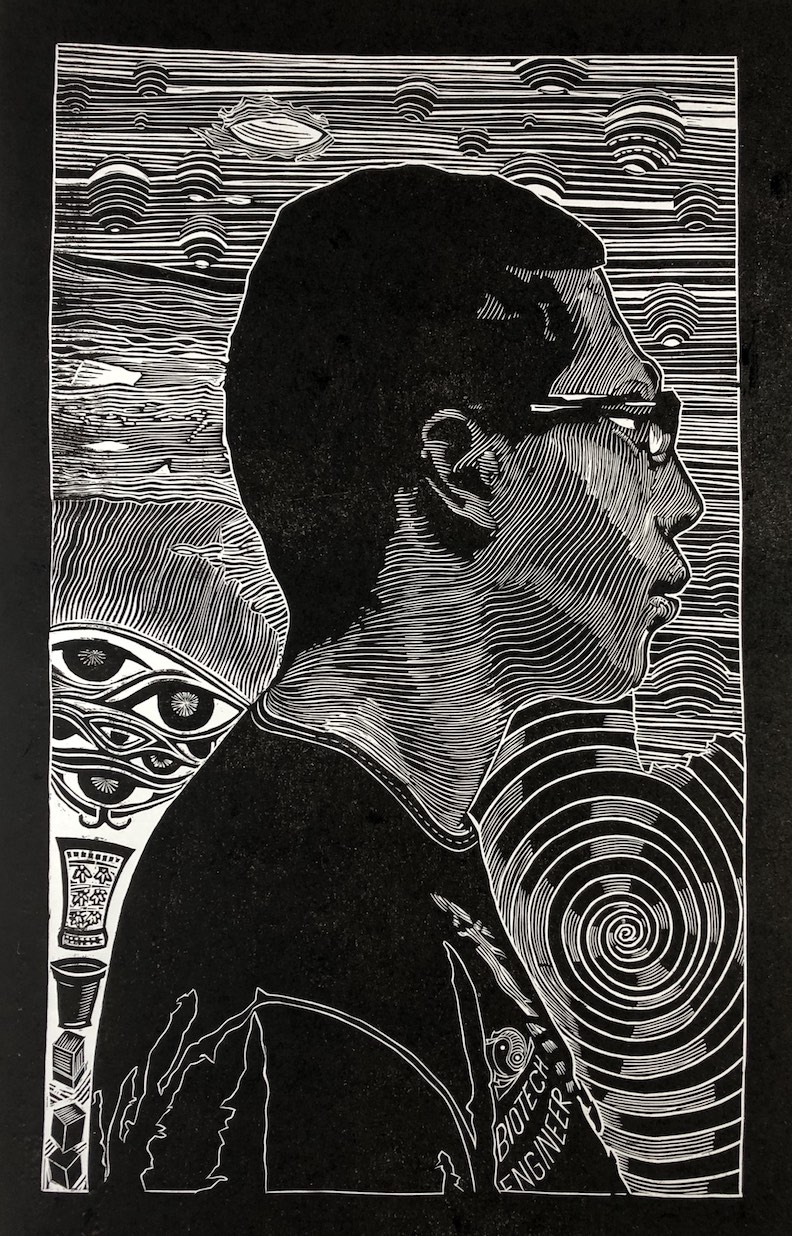
Biotech Engineer
Linocut, 30″ x 22″, 2022
CDL: This may seem like a strange question, but every artist I’ve asked, always gives an interesting answer. Have you had any paranormal experiences? For example, ghosts or strange creatures?
RHA: Not at all. I have heard many other people I know, friends and relatives, who have experienced some level of paranormal experience. Specifically hearing things, seeing people who are no longer alive and another friend who can sense what things are going to happen before they do. She sees herself as a medium.
CDL: Ok, so I’m kind of laughing at myself about your answer, because I look at your work and see a mystical quality about it and also, the subjects of some of your work/portfolio calls include nagual imagery. (in MesoAmerican folktales a nagual or nahual is a human being who has the power to shapeshift into an animal counterpart)I thought surely this artist has some kind of supernatural insight! Maybe I’m projecting?
RHA: No, I think you’re seeing something right. I’m definitely trying to show what is behind the portrait, the soul. An essence.
CDL: Ok, I knew it!
If you’d lke to see more of Rene Arceo’s work, please visit his website at https://arceopress.com/ and purchase prints at https://www.etsy.com/shop/ArceoStudio
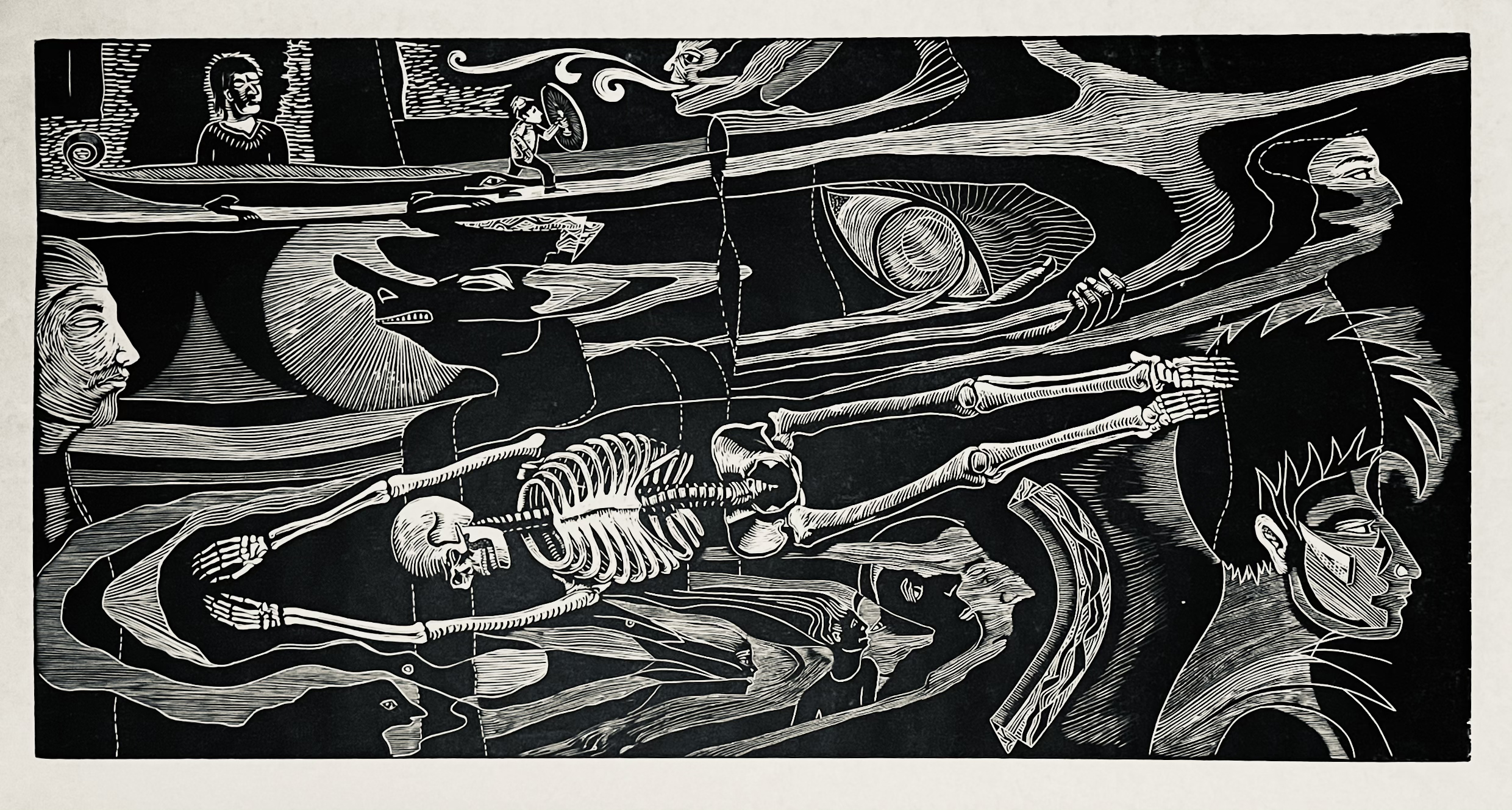
El difunto y sus fantasmas
Woodcut, 31″ x 52″, 2021
